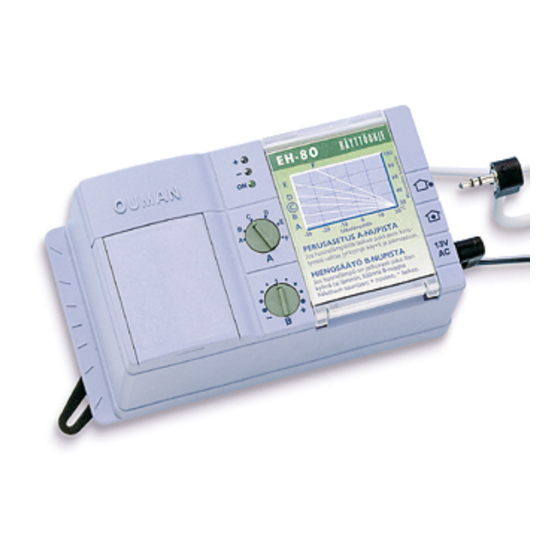
Advertisement
Quick Links
EH-80
OPERATING INSTRUCTIONS
F
E
D
C
B
A
-20
10
-30
-10
0
Outdoor temperature
BASIC SETTING, KNOB A
If the room temperature goes down when the
weather gets colder, select a steeper curve
and vice versa.
FINE ADJUSTMENT, KNOB B
If the room temperature is always too cool or
warm, turn knob B in the desired direction;
+ raises, - lowers the temperature.
O U M A N
CONTROL CURVES
E H- 80
The OUMAN controller contains a wide range of
control curves that are designed to respond to very
different kinds of heating conditions. It also has low
curves suitable for houses with floor heating.
For example, read control curve C as follows:
C
-30
-20
-10
0
10
Outdoor temperature
When it is -20°C, the outgoing water is 50°C
When it is 10°C, the outgoing water is 44°C
When it is 0°C, the outgoing water is 37°C
O U M A N
O U M A N
BASIC SETTING
E H- 80
Select a house-specific control curve
with knob A.
Set the basic setting according to the
table below.
Heating characteristics of the building
Position of knob A
Well-insulated house (radiator heating)
House with poor heating characteristics
House with a floor heating system
F
C
D
E
Select the steepness of
B
E
the curve with knob A
D
A
F
C
B
A
A
Curve C is selected in this example. If the room
temperature goes down when the weather gets cold,
select a steeper curve. If the room temperature goes up,
select a lower curve. A suitable curve for your house may
be between the plotted curves.
O U M A N
FINE ADJUSTMENT
E H - 8 0
If the room temperature is even, but
it is too cool or warm, make a fine
adjustment with knob B.
* If the room temperature is always too cool, turn knob
B in the + direction.
* If the room temperature is always too warm, turn
knob B in the - direction.
One step of the scale of knob B changes the outgoing
water temperature by 4°C, corresponding to about 1°C
in the room temperature.
Knob B raises and
lowers the selected
+
curve.
–
+
–
B
NOTE ! Changes in the settings are felt quite slowly.
Wait a few hours before making additional adjustments.
O U M A N
OPERATING PRINCIPLE
E H - 8 0
OUMAN automatically adjusts the
100
temperature of the water entering the
network. The heat requirement varies
80
60
BOILER OR
40
ACCU-
MULATOR
20
20
°C
When the weather gets cooler, OUMAN
releases just enough heat into the network
BOILER OR
ACCU-
MULATOR
O U M A N
E H - 8 0
Blinking
LED
100
The controller is
+
increasing the heat. Not enough heat in the boiler.
80
(Valve is opening)
60
The controller is
decreasing the heat summer when no heat is
–
(Valve is closing)
40
20
20
ON
°C
If the green ON indicator lamp is not on, check that
the transformer is plugged in and the transformer lead
is connected. Check the line voltage.
O U M A N
MIN - MAX - LIMITS
EH -80
The settings located behind the
instruction booklet under the clear
cover are usually set only when the
controller is taken into use the first time.
C...D
The maximum limit knob sets the
E... F
highest allowable outgoing water
A... B
temperature. This is especially beneficial
in floor heating systems, where overly
hot water may cause damages.
The minimum limit knob sets the lowest
allowable outgoing water temperature
(if sufficient heat is available).
O U M A N
MANUAL OPERATION
E H - 8 0
The OUMAN 80 can also be used manually. Unplug the
transformer to disconnect the operating voltage. Press
the button on the bottom right all the way down while
turning the valve to the desired position with the manual
control lever.
NOTE ! If you wish to disconnect the controller for a
longer period (e.g., in summer), disconnect the operating
voltage (13 VAC) connector from the controller. The
clock battery will also be disconnected to avoid unnecessary
battery drainage (battery life = about 180 days). The
battery is a backup power supply for the clock and
programming during power shortages.
according to the outdoor
HEATING
NETWORK
to maintain an even room
temperature.
HEATING
NETWORK
INDICATOR LAMPS
On continuously
The valve is competely open.
The valve is closed. In the
needed this lamp may always
be on.
The unit is operating.
Advertisement

Summary of Contents for OUMAN EH-80
-
Page 1: Manual Operation
E H - 8 0 E H - 8 0 If the room temperature is even, but The OUMAN 80 can also be used manually. Unplug the it is too cool or warm, make a fine transformer to disconnect the operating voltage. Press the button on the bottom right all the way down while adjustment with knob B. - Page 2 ROOM COMPENSATION TMR/P compensation ratio, can be adjusted with the COMP knob. The OUMAN EH 80 can be equipped with an optional room If the room temperature deviates from compensation unit, TMR/P. It improves temperature control the TMR/P set value, the TMR/P adjusts...
Need help?
Do you have a question about the EH-80 and is the answer not in the manual?
Questions and answers